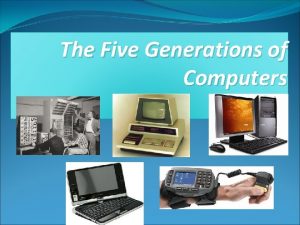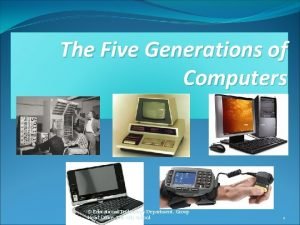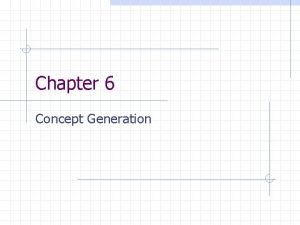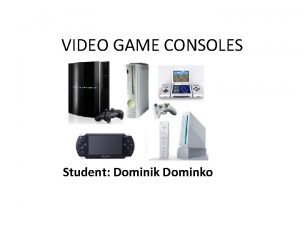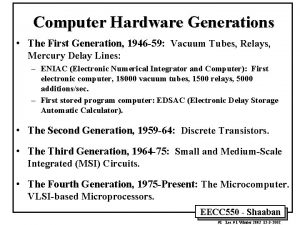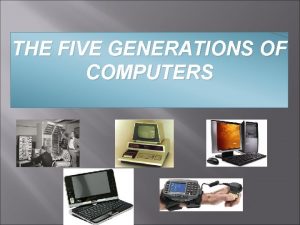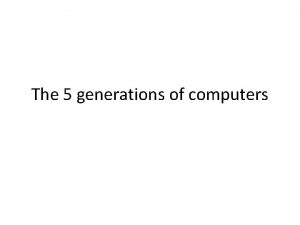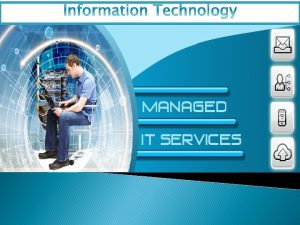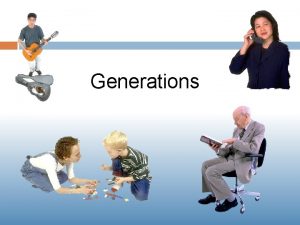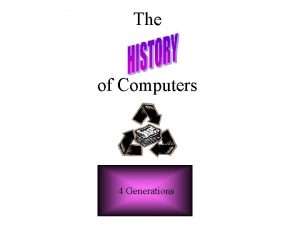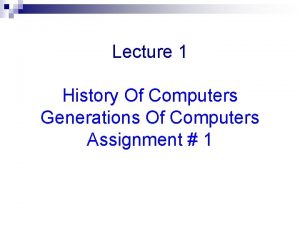The Five Generations of Computers First generation computers













- Slides: 13

The Five Generations of Computers

First generation computers (1940 -1956) The first computers used vacuum tubes for circuitry and magnetic drums for memory. They were often enormous and taking up entire room. First generation computers relied on machine language. They were very expensive to operate and in addition to using a great deal of electricity, generated a lot of heat, which was often the cause of malfunctions. The UNIVAC and ENIAC computers are examples of firstgeneration computing devices. 19 -12 -2021 UEM, Kolkata 2

First generation computers ENIAC 19 -12 -2021 UEM, Kolkata 3

Second generation computers (1956 -1963) • Transistors replaced vacuum tubes and ushered in the second generation of computers. • Second-generation computers moved from cryptic binary machine language to symbolic. • High-level programming languages were also being developed at this time, such as early versions of COBOL and FORTRAN. • These were also the first computers that stored their instructions in their memory. 19 -12 -2021 UEM, Kolkata 4

Second generation computers IBM 7094 19 -12 -2021 UEM, Kolkata 5

Third generation computers (1964 -1971) The development of the integrated circuit was the hallmark of the third generation of computers. Transistors were miniaturized and placed on siliconchips, called semiconductors. Instead of punched cards and printouts, users interacted with third generation computers through keyboards and monitors and interfaced with an operating system. Allowed the device to run many different applications at one time. 19 -12 -2021 UEM, Kolkata 6

Third generation computers Integrated Circuits 19 -12 -2021 UEM, Kolkata 7

Fourth generation computers (1971 -present) The microprocessor brought the fourth generation of computers, as thousands of integrated circuits were built onto a single silicon chip (VLSI). The Intel 4004 chip, developed in 1971, located all the components of the computer. From the central processing unit and memory to input/output controls—on a single chip. . Fourth generation computers also saw the development of GUIs, the mouse and handheld devices. 19 -12 -2021 UEM, Kolkata 8

Fourth generation computers 19 -12 -2021 UEM, Kolkata 9

Fifth generation computers (present and beyond) The term “Generation 5” is used sometimes to refer to all more or less “sci fi” future developments like: q Voice recognition q Artificial Intelligence q Quantum computing q Bio computing q Nano technology q Natural language processing 19 -12 -2021 UEM, Kolkata 10

Fifth generation computers 19 -12 -2021 UEM, Kolkata 11

Summary (Generations of Computer) 19 -12 -2021 UEM, Kolkata 12

Thank You… 19 -12 -2021 UEM, Kolkata 13
 Fifth generation of computer examples
Fifth generation of computer examples First generation computers advantages
First generation computers advantages First generation antipsychotics vs second
First generation antipsychotics vs second 4th generation of computer
4th generation of computer Giga tera peta
Giga tera peta Transistors were used in which generation of computers
Transistors were used in which generation of computers Lord you are good and your mercy is forever
Lord you are good and your mercy is forever Concept generation table
Concept generation table First generation of video game consoles
First generation of video game consoles First generation of rights
First generation of rights First generation of computer
First generation of computer Examples of right
Examples of right First generation cephalosporin
First generation cephalosporin Glibenclamide class
Glibenclamide class
